
Editor's Note: This is the second part of a two-part series on a pair of 2005's top draft picks. To read the first part, on Alex Gordon, click here.
In part II (the last) of this series, we'll take a look at former No. 3 overall pick from the 2005 draft, Jeff Clement. Again, this isn't to second guess the selection by the Mariners, but to examine what has befuddled Clement at the Major League level.
From leading his Marshalltown, Iowa Little League team to the Little League World Series to breaking Drew Henson's high school home run record with 75 to blasting 46 home runs in three seasons at USC, Clement has always been known for his immense raw power. What made scouts salivate even more was that Clement was a catcher, and left-handed, light tower power at the catcher position comes around about as often as Ben Affleck has a solid acting role (Bryce Harper be darned).
Clement posted solid numbers at each minor league stop, and continued to show the raw power that helped him earn a $3.15 million signing bonus from the Seattle Mariners. But Clement's time at the Major League level has been anything but easy, with his career OPS of .655, albeit he currently only has 336 MLB plate appearances.
Let's take a look at Clement's swing and see what, if anything, is impeding his progress.
As you can see below, Clement is not lacking for strength. Ability to drive the ball out over the plate and out of the ballpark to the opposite field? He can do that (left clip). Ability to sit down and hang in against a tough lefty's (Randy Wolf) curveball and hammer it out down the right field line? He can do that too (right clip).
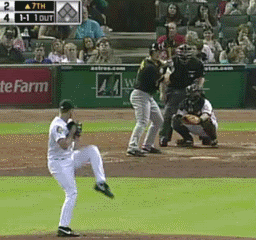

Leverage?
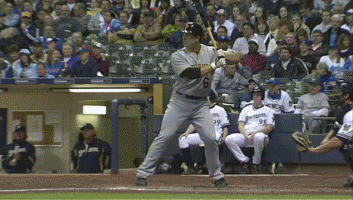
Oh yeah. He's got that too.
So what exactly is holding Clement back from consistently contributing at the Major League level?
Here's our culprit:
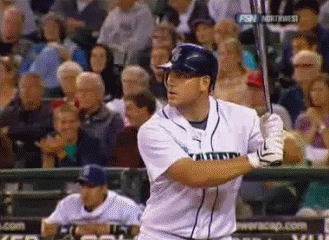

Upper Body
Take note of Clement's lead arm and barrel positioning when he launches his swing. He coils up his upper body via counter rotation of his shoulders. Some counter rotation can be a good thing and help upper vs. lower separation, but too much counter rotation and relying on the uncoiling of the shoulders to power the upper body is long, slow, and inefficient. At the same time his shoulders reverse rotate, his lead arm pushes back and around behind him and since he doesn't have his top hand conscious of where his barrel goes, his barrel ends up slotting in behind his helmet, getting trapped in the process.
Clement's barrel positioning at launch greatly increases the distance from launch to contact. And his fully extended lead arm takes a long time to get out of the way and deliver the barrel forward into the hitting zone. On top of the extra length, it is a slower than normal process because Clement has his shoulders and other big muscles trying to uncoil into the baseball -- rather than his quicker firing smaller muscles.
Because Clement uses his big muscles (hips, shoulders, arms and chest) to do all the work, his hands are long and slow to the ball. He doesn't engage his hands to get the barrel moving, which doesn't give his top hand a chance to maintain control of the barrel -- and, as I mentioned earlier, it ends up getting buried behind his helmet.
Rhythm and Lower Body
Take note of Clement's rhythm as well. Rhythm is a good thing, but a "grooved rhythm" like Clement has actually ends up interfering with his timing. All of his movements are timed to one singular groove, a groove that is based on the pitcher preparing to throw, not the incoming pitch. Clement's rhythm detracts from his body control and ends up creating grooved actions and a grooved swing plane. Another hitter with a groove rhythm and heavy shoulder involvement in their swing is Brandon Inge. Difference between he and Clement is Inge has a much better launch position allowing him a (slightly) more consistent swing plane.
Clement has decent lower-body mechanics, as he's relatively balanced and gets a very good coil to allow him to forcefully explode his lower body into the ball.
One player with a somewhat similar handset and lower body coil as Clement is Brian Roberts. Clement could learn a lot from Robert's technique and efficiency.
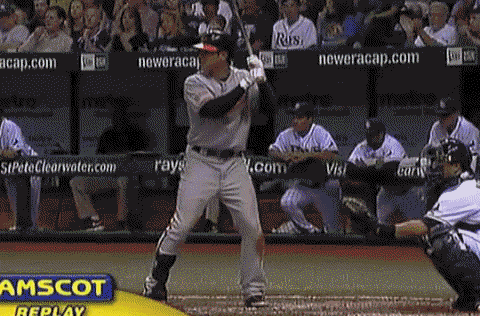
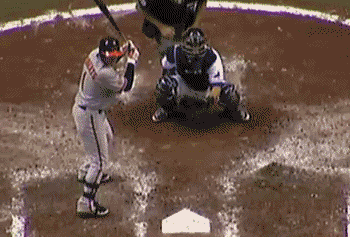
Clement vs. Roberts
Yes, they are completely different players with completely different builds. But a lot can be learned from examining the quicker and more efficient hitter in Roberts.
The first thing to notice is their rhythm.
Roberts' rhythm -- his pre-pitch slight body rock -- is coordinated to the pitcher's movements as well as the pitch's location and movement, with emphasis on the latter. He gets a good load and is on balance, but his movements are not grooved like Clement's are. Roberts can adjust his body in a far easier manner than the grooved rhythm allows Clement to do. Clement's rhythm is his "gathering" move, or how he gathers himself before attacking. Roberts, on the other hand, has his rhythm lead into or precede his gathering move. For Roberts, one thing leads to another, which allow both (rhythm and gather) to work properly. Clement does both at the same time, which merges both processes together causing him to lose all forms of hand resistance and hand adjustments to adjust to the incoming pitch.
Or another way of saying it is Roberts' rhythm leads to his gather, he feels his gathering point, sees the pitch, and attacks from there. Clement has all of that run together into one motion. He has no separation of each individual -- and important -- process. Roberts is sequential in his actions while Clement's rhythm blends into his coil which blends into his uncoil. He has no sequence to the movements, they end up happening in one continuous movement.
The second thing to notice is what each do with their hands.
Both slightly push back with their lead arm -- Clement more so than Roberts, plus Clement's excessive reverse shoulder rotation -- to get a load, but they differ in what they do with their top hand. Clement's lack of top-hand involvement allows his lead arm to continue pushing back and around behind him. Whereas Roberts cocks his wrists with his top hand, which allows him to be conscious of where his barrel is. He knows where the barrel is at all times, and the cocking of the wrists keeps his barrel in a good position to be launched from. This keeps him quick and efficient though the zone.
Or in Layman's terms, Clement loses his barrel behind him and his swing path is extremely long to the ball, and Roberts is conscious of his barrel and keeps it in a good and efficient launch position.
The last thing to notice is probably the most glaring.
Roberts is the very definition of "hips and hands", while Clement is of the "hips, shoulders, chest, arms, and exaggerated upper body twist" mold. One is extremely efficient, one takes a much longer time to execute. Since Roberts is a "hips and hands hitter", he does a much better job of staying square to the plate and maintaining true angles to the ball and hitting zone than Clement. Since Clement coils up around behind him, his body's movements and the laws of physics and kinesiology force him to uncoil/unload in a long, slow, grooved plane.
Conclusions
Jeff Clement's swing length and reliance on his big muscles to power his swing helped him dominate pitching less advanced than his talent and make him the No. 3 overall pick in 2005, but it has ended up hurting his ability to translate his tremendous raw power consistently at the Major League level. Clement is simply lacking the quickness and efficiency needed to succeed at the game's highest level.
If he can learn to do less with the big muscles and more with the small muscles along with keeping his barrel in a good launch position, Clement would be a far more consistent hitter. Or at least one with a far more consistent swing plane. Should Clement adjust his rhythm into timing, his ability to adjust at the plate would be improved even more. Then he would be able to unleash his huge raw power on a consistent basis. The strength and power is there to hit 30+ home runs, but it's the technique that is holding him back right now.
Follow Steve Carter on Twitter, or you can reach him at stevecarterpp@hotmail.com
